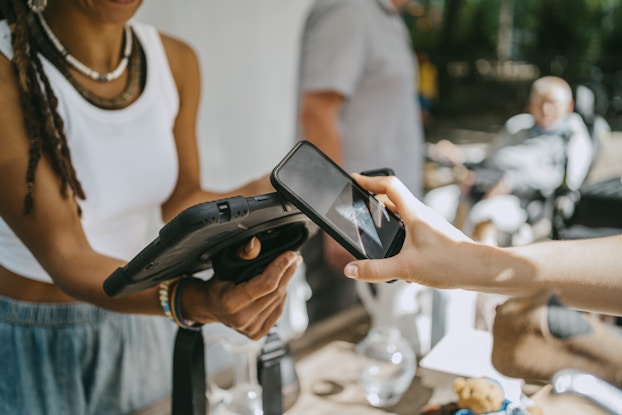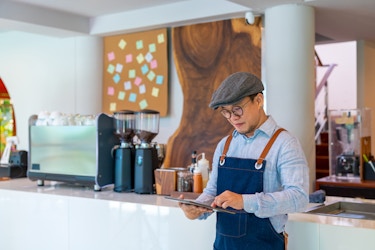
Why it matters:
- New forms of digital payment technologies are increasingly helping businesses boost customer convenience by reimagining the checkout process, while uniting the in-store and online shopping experience.
- Contactless payments with no physical terminal have helped cut down on lines at Sephora, for example, as sales associates can ring up customers from anywhere in the store via an iPhone.
- Businesses are finding that biometrics—identification systems that use a person’s physical features, such as face scans and fingerprints—can also speed up the checkout process and help personalize the buying experience.
When Heather Driscoll, Founder of Magical Box Bakery in Newark, California, started using tap-to-pay technology during the height of COVID-19, customers appreciated the no-contact service.
“During the pandemic, contactless was king,” Driscoll said. “No one wanted to touch anything, so not having to hand over a credit card made people more comfortable.”

Interested in a small business membership?
Find out how the U.S. Chamber of Commerce can help your company grow and thrive in today's rapidly-evolving business environment. Connect with our team to learn how a small business membership can benefit your bottom line and help you achieve your goals.
But since Driscoll began using Tap to Pay through Venmo, she’s noticed real business benefits, too: Managing all transactions in one place has made her more efficient, and she’s not alone. Four in five merchants (86%) responding to a Discover Global Network survey strongly agree contactless payments have helped reduce lines, 78% said they decreased average transaction times, and 85% cited increased customer satisfaction.
Now, as Driscoll forges ahead with a new venture — building out a coffee trailer — she plans to continue using touchless payments, and she may even experiment with new ways of paying on the horizon. For business owners, payment methods like biometrics and technology that lets customers pay from anywhere in-store represent the next frontier of contactless payments, and interest in them is growing.
Reimagining the checkout experience: Businesses are moving beyond the register to allow customers to make purchases where they want
A major customer pain point has long been lines at the register. People get frustrated and impatient with slow-moving lines, which impacts their impression of a brand.
Long lines also often drive consumers to competitors. One survey showed 39% of shoppers have left a store without purchasing any items due to long lines, while 56% were likely to change stores if the main difference between retailers was a better checkout process.
It’s a problem JPMorgan Chase set out to solve, in part, with its Tap to Pay on iPhone for merchant clients in the U.S.. With the technology, businesses can accept contactless payments without a physical terminal. Sales associates are able to ring up customers from anywhere in the store.
The new technology is part of the bank’s omnichannel payments solution that unites online and in-store payments and also wraps a stores’ customer loyalty program into every transaction.
Sephora was the first to roll out the technology across all of its U.S. freestanding stores. Now, the beauty chain’s beauty advisors can take credit, debit, Apple Pay, and other digital wallets payments using their iPhone and the mobile point-of-sale app while they’re walking around the store helping customers.
The solution cuts down on lines and gives salespeople the time to create more meaningful connections with customers, said Jean-Marc Thienpont, managing director of Omnichannel & Biometric Solutions at J.P. Morgan Payments. “It helps with traffic peaks, too, and for businesses to never miss a sale.”
J.P. Morgan Payments is working to expand the technology to small- and-medium-sized businesses. Thienpont expects the new technology to become accessible to businesses of all sizes in the not-so-distant future.
[Read: How ‘Retail Concierges’ (Both Digital and Human) Are Poised to Disrupt the Shopping Experience]
Embracing biometrics payments: Paying with one’s face or palm can save valuable seconds and personalize the shopping experience
Interest is growing in biometric payment technology, too.
Biometrics makes it possible for customers to pay in-store by scanning their palm or their face at checkout, no card or phone needed. Customers first enroll through their card provider and can pay with biometrics anywhere the card is accepted. Card providers manage the data, not merchants.
At least six new or newly updated biometrics products were showcased at this year’s annual National Retail Federation convention in New York in January, and companies from J.P. Morgan to Mastercard have started piloting biometrics in stores.
“Queuing is the biggest issue we’re trying to solve for,” said Thienpont. “Biometrics speeds up the check-out process.”
The bank recently tested biometric payments with food service provider Aramark in Plano, Texas. The more than 1,000 customers of an Aramark café at J.P. Morgan’s Plano campus had the option to scan their palms to buy lunch, snacks and coffee.
Long lines also often drive consumers to competitors. One survey showed 39% of shoppers have left a store without purchasing any items due to long lines, while 56% were likely to change stores if the main difference between retailers was a better checkout process.
“We learned a lot,” Peter Czimback, Vice President of Digital Experience for Aramark Emerge, told CO—. Customers took around eight transactions to learn exactly where to place their palm. “And once you got comfortable, you got fast. It was quicker than your traditional tap or swipe with your credit card, and the majority of people were open to it.”
Czimback said the average two seconds saved on hundreds of customer payment transactions per hour via biometrics “is absolutely material” to Aramark’s business.
And by pairing data gleaned from using digital payments with generative AI, companies can also create great emotional moments for customers after they learn people’s buying habits, he said. “The technology is going to get better, faster, cheaper, and more pervasive, and I do think you’ll see it more and more.”
Mastercard, for its part, launched its Biometric Checkout Program in 2022 at five St. Marche grocery stores in Sao Paulo, Brazil, and said it plans to roll out the technology globally. Amazon has done the same at Whole Foods stores in Seattle. By 2025, some 1.4 billion people are expected to be using facial recognition technology to authenticate a payment, according to Juniper Research.
“Technically, there’s no reason this technology wouldn’t work in every store,” Thienpont said.
JP Morgan’s Prashant Sharma, Executive Director for Biometrics and Identity Solutions, said these types of digital innovations will help personalize and customize the shopping experience, opening up additional selling opportunities.
For example, if a customer shopping in person finds a dress they like but want it on another color, they could buy the right shade using the store’s biometric self-service kiosk and have it shipped to their home later that day. “It’s a journey that’s mixing channels,” he said.
Sharma anticipates consumers may start to see biometrics kiosks in some stores in the second quarter of 2024, with more business adopting the technology into early 2025. As for security concerns, Sharma said this type of technology is already successfully being used in U.S. airports as part of customs’ Global Entry program.
“There’s nothing really that anyone can do with that data,” Sharma said. “And anything that happens will happen with user consent.”
[Read: Mastercard, Affirm, and Klarna Lean Into SMB and Millennial Market Demands to Unlock Growth]
Streamlining in-store and online experiences — particularly to capture Gen Z
Experts say new digital payments technologies will help businesses to better streamline the in-store and online shopping experience. Uniting in-store and online experiences however possible is critical to shoppers, especially Gen Z.
Gen Z, alone, accounts for more $100 billion dollars in combined spending power globally, according to Deloitte, and increasingly sees in-store shopping as a social outing and a chance to see friends in real life. In a recent poll, 97% of Gen Z respondents said they shop at brick-and-mortar stores in tandem with online shopping.
At the same time, today’s customers are demanding in-store transactions that are just as fast and seamless as they get with one-click buying online. Customers who know their in-store experience will go smoothly may be more likely to drop by the store in person, giving businesses the chance to interest them in new products.
“Especially post-Covid, consumers today want a complete, seamless journey across channels,” said Thienpont. “It’s about streamlining and unifying the checkout experience across in-store, online, and mobile channels.”
Driscoll of Magical Box Bakery said she’s open to trying all kinds of payments, as long as they’re cost effective. “With a mobile food business, I can’t use a traditional register, so if these newer forms of payment had a small and inexpensive reader, I would absolutely be open to trying it.”
CO— aims to bring you inspiration from leading respected experts. However, before making any business decision, you should consult a professional who can advise you based on your individual situation.
CO—is committed to helping you start, run and grow your small business. Learn more about the benefits of small business membership in the U.S. Chamber of Commerce, here.







